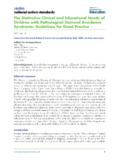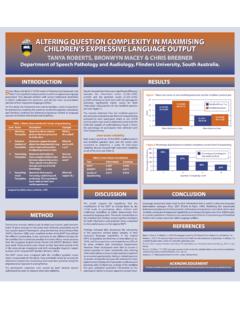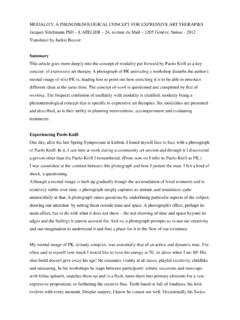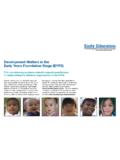Transcription of MY FIRST BARRIER GAMES - Pelican Talk
1 MY FIRST BARRIER GAMES Copyright 2007 Lucia Smith. All Rights Reserved. Pelican TALK SPEECH THERAPY RESOURCES. Individual pages may be phot ocopied for clinical purposes only. 1 By Lucia Smith 2007 MY FIRST BARRIER GAMES MY FIRST BARRIER GAMES Copyright 2007 Lucia Smith. All Rights Reserved. Pelican TALK SPEECH THERAPY RESOURCES. Individual pages may be phot ocopied for clinical purposes only. 2 BARRIER GAMES What are they? Simply put, BARRIER GAMES involve two players separated by a BARRIER . Each player is given a set of the same objects or a picture of the same scene. The BARRIER is such that each person can hear the other, but cannot see the other s objects or picture.
2 This places the emphasis on language. One player (Player One) arranges their objects or colours something on their picture and then tells the other player (Player Two) about what they have done. Player Two must then arrange their objects or colour their picture in an attempt to make them exactly the same as Player One s. If a clear message was delivered, understood and followed, both pictures or object arrangements should be the same when the BARRIER is removed. (We will discuss in detail the steps involved later in this manual). BARRIER GAMES are brilliant for developing expressive and receptive language and also the concept of referential communication. My FIRST BARRIER GAMES also promotes the use of specific questioning through question probes.
3 This assists in developing clarification requests. BARRIER GAMES can be used in individual speech pathology sessions, in home programs or in schools as part of whole class programming. There is also a turn-taking component of BARRIER GAMES , which, when played by an adult and child, allows the adult to provide a clear model of speech when it is their turn to produce a message. Children with language delay can learn from this speech model. This is why, in the initial stages of using BARRIER GAMES , they are best played by an adult and child (if the child has a language delay). BARRIER GAMES can be used in a variety a ways. The following pages will help you see how you can adapt the activities to each child s needs and abilities.
4 Expressive language = the production of a message Receptive language = understanding a message Through BARRIER GAMES , we aim to encourage the production of clear, efficient and unambiguous messages, and careful listening. MY FIRST BARRIER GAMES Copyright 2007 Lucia Smith. All Rights Reserved. Pelican TALK SPEECH THERAPY RESOURCES. Individual pages may be phot ocopied for clinical purposes only. 3 What is Referential Communication? Referential Communication = the ability to relate information from one person to another using a clear and unambiguous message. Children younger than 7 years can have difficulty with referential communication. Children with language difficulties, particularly children on the autism spectrum, often have poor referential communication skills.
5 A child with poor referential communication has trouble judging what the listener already knows and what information they need to be told. The child often assumes that the listener knows what the child already knows and they, therefore, fail to provide the listener with a clear, full, unambiguous message. BARRIER GAMES can help these children learn that a listener may have no previous knowledge of the content of what the child is speaking about and may be relying entirely on the child s words to generate that knowledge. An example of poor referential communication is: CHILD: Mum, Mr. Johns said that you need to get one of those keyboard things for me . (Mum doesn t know who Mr. Johns is and child has not thought to explain Mum also does not know what one of those keyboard things is.)
6 The child has assumed that his mother knows this because it s very obvious to him what a keyboard thing is!) 1. ( Using A BARRIER Game Form at to Improve Children s Referential Com munication Skills . Betty. H. Bunce. Journal of Speech and Hearing Disorders. Vol. 54, 33-43. February 1989). What are Clarification Requests? Clarification Requests = questions that help a listener to understand a message when it has not been understood the FIRST time. Good clarification requests follow the route below: Listener hears a message and does not understand it. fl 1. Listener notes that they have not understood the message. fl 2. Listener pinpoints exactly which part of the message was not understood.
7 Fl 3. Listener asks the speaker a specific question so the speaker s answer can provide the required information. BARRIER GAMES have been shown to significantly improve the referential communication skills of children with learning disabilities. 1 MY FIRST BARRIER GAMES Copyright 2007 Lucia Smith. All Rights Reserved. Pelican TALK SPEECH THERAPY RESOURCES. Individual pages may be phot ocopied for clinical purposes only. 4 Most adults have no problems with clarification requests and it seems strange to break the steps down as such. It is important to do this, however, as a child with language difficulties may have trouble at steps 1, 2 or 3. They may need explicit instruction and practice at the steps where the difficulty is occurring.
8 My FIRST BARRIER GAMES can be used to probe whether a child can ask for clarification and whether they can do this in a specific manner. Intermittently, through the BARRIER game activities, it encourages an adult to give the child an unclear message and then wait to see if the child asks a specific question to clarify. The procedure for this is included later in this manual. Children with language difficulties can find clarification requests difficult. When they do not understand a message, they may not ask for clarification at all or ask for clarification in a non-specific manner. An example of a poor request for clarification: MUM AND CHILD ARE AT THE SUPERMARKET CHECK-OUT MUM: Oh, I forgot the you go and grab me four kiwifruit please.
9 Quickly! (Child doesn t know what kiwifruit are). CHILD: What? MUM: Some and get me four of them please .. they are in the fruit section. Because the child didn t ask a specific question, the mother clarified the wrong part she explained where they were, not what they were. The child still doesn t know what kiwifruit are. Concepts: BARRIER GAMES can also be used to teach concepts. After all, when you try and describe a picture, you need words like long, short, big, small, next to, under and also names of things like dog, cat, egg and so on. Many BARRIER GAMES are too difficult for young learners as there are two many variables. They are provided with two many objects and too many possible positions.
10 With young children, or children who have language difficulties, it can be impossible to finish up with too identical pictures. My FIRST BARRIER GAMES provides simple pictures that are non-ambiguous. Each picture targets a specific concept - either a preposition (under, in, on) or an adjective (long, short, big, little). Children are assisted in using these words in a carefully graded manner FIRST there are only two variables and later there are more and more. Once again, this is all explained later in the manual. More detail about Teaching and Learning Concepts is on Page 18. All the concepts targeted are all listed in the RECORD SHEET on Page 17. Clarification Requests can repair a failed communication attempt.






